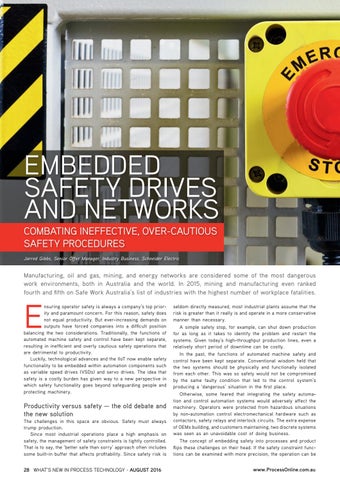EMBEDDED SAFETY DRIVES AND NETWORKS COMBATING INEFFECTIVE, OVER-CAUTIOUS SAFETY PROCEDURES Jarred Gibbs, Senior Offer Manager, Industry Business, Schneider Electric
Manufacturing, oil and gas, mining, and energy networks are considered some of the most dangerous work environments, both in Australia and the world. In 2015, mining and manufacturing even ranked fourth and fifth on Safe Work Australia’s list of industries with the highest number of workplace fatalities.
E
nsuring operator safety is always a company’s top priority and paramount concern. For this reason, safety does not equal productivity. But ever-increasing demands on outputs have forced companies into a difficult position balancing the two considerations. Traditionally, the functions of automated machine safety and control have been kept separate, resulting in inefficient and overly cautious safety operations that are detrimental to productivity. Luckily, technological advances and the IIoT now enable safety functionality to be embedded within automation components such as variable speed drives (VSDs) and servo drives. The idea that safety is a costly burden has given way to a new perspective in which safety functionality goes beyond safeguarding people and protecting machinery.
Productivity versus safety — the old debate and the new solution The challenges in this space are obvious. Safety must always trump production. Since most industrial operations place a high emphasis on safety, the management of safety constraints is tightly controlled. That is to say, the ‘better safe than sorry’ approach often includes some built-in buffer that affects profitability. Since safety risk is
28 WHAT'S NEW IN PROCESS TECHNOLOGY - AUGUST 2016
seldom directly measured, most industrial plants assume that the risk is greater than it really is and operate in a more conservative manner than necessary. A simple safety stop, for example, can shut down production for as long as it takes to identify the problem and restart the systems. Given today’s high-throughput production lines, even a relatively short period of downtime can be costly. In the past, the functions of automated machine safety and control have been kept separate. Conventional wisdom held that the two systems should be physically and functionally isolated from each other. This was so safety would not be compromised by the same faulty condition that led to the control system’s producing a ‘dangerous’ situation in the first place. Otherwise, some feared that integrating the safety automation and control automation systems would adversely affect the machinery. Operators were protected from hazardous situations by non-automation control electromechanical hardware such as contactors, safety relays and interlock circuits. The extra expense of OEMs building, and customers maintaining, two discrete systems was seen as an unavoidable cost of doing business. The concept of embedding safety into processes and product flips these challenges on their head. If the safety constraint functions can be examined with more precision, the operation can be
www.ProcessOnline.com.au
